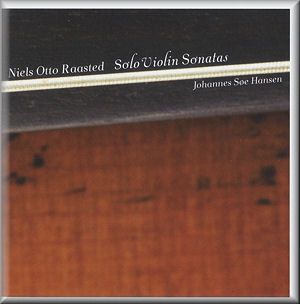 |
 |
|


alternatively
CD: MDT
AmazonUK
AmazonUS
Sound
Samples & Downloads
|
Niels Otto RAASTED (1888-1966)
Sonata for solo violin, Op. 30 No. 1 [12:59]
Sonata for solo violin, Op. 30 No. 2 [13:26]
Sonata for solo violin, Op. 18 No. 1 [14:26]
Sonata for solo violin, Op. 18 No. 2 [12:52]
Sonata for solo violin, Op. 18 No. 3 [12:29]
 Johannes Søe Hansen (violin)
Johannes Søe Hansen (violin)
rec. 23-25 February 2010, Royal Danish Academy of Music, Copenhagen,
Denmark
 DACAPO 6.220563 [66:12]
DACAPO 6.220563 [66:12] 
|
|
|
When I first received this CD, I had never heard of Niels Otto
Raasted. When they first received the CD, retailers MDT and
Presto Classical had never heard of him either; indeed, Raasted’s
last appearance on disc was in 1997, when the Kontrapunkt label
included one of his works on a “Danish Organ Music” album. Violinist
Johannes Søe Hansen personally dug up the manuscripts to these
solo violin sonatas in a Danish library, so this is about as
little-known as little-known music gets. And yet Raasted’s solo
violin sonatas are in fact modeled on some of the best-known
music ever written: Bach’s violin sonatas and partitas.
Niels Otto Raasted, according to the informative and well-written
booklet, was sent to Germany by his parents in order to undertake
an apprenticeship as a goldsmith. He returned home with a degree
in organ performance, a letter of recommendation from one of
the world’s most prominent organists (Karl Straube), and lesson
notes from composition study with Max Reger. He then settled
in to a very long career as one of Denmark’s premier organists,
presiding over the instrument at Copenhagen Cathedral for over
thirty years and, in addition to regular performance, composing
chorales and hymns.
In the early years of that career, though, before taking up
the prestigious Copenhagen job, Raasted wrote for other instruments
too; the booklet mentions three symphonies, and the CD itself
presents for our inspection five sonatas for solo violin, written
in 1918 and 1921. None have been recorded before. All are deeply
indebted to Bach and Reger, and all impress with their sincerity
and musicality, even if they do not strike me as inspired.
Some are more derivative than others. There is a D minor set
that ends with a chaconne, for instance, and the chaconne is
a slavish but short imitation of Bach’s. In fact all of the
sonatas bear the stamp of Bach, the technical challenges of
whose sonatas and partitas are never really exceeded, and of
Reger, the emotional plainness of whose studies is omnipresent.
That is not entirely fair: the finale of Op 18 No 1 is a recognizably
cheery little air, the fugue in Op 18 No 2 is very dramatically
constructed, and the pizzicato scherzo of Op 30 No 2 is a delight
and a dramatic contrast with the emphatic finale. Op 30 No 2,
in A minor, is the standout sonata in the group. But generally
Raasted seems to be aiming for a sense of dignity, confidence,
and majesty, rather than the emotional volatility of Ysaÿe’s
roughly contemporaneous solo sonatas.
The problem Raasted faced when modeling these works on Bach
is obvious: in any game of comparisons, Bach will always win.
The Dane appears to have known this to some degree. The Raasted
works are intentionally modest in dimensions (the longest, fourteen
minutes), fairly modest in emotional scope and impact, and humble
in their demands on the listener. It feels cruel to say that
this music is similarly modest in its interest, but I do not
know how else to put it. Johannes Søe Hansen plays with devotion
and full technical command, but he might indulge Raasted’s solemn,
buttoned-down conservatism a little too much. Or perhaps he
found it impossible to escape, and is simply communicating the
music’s solid construction as clearly as he can. The sound is
good but a bit reverberant, which enhances the music’s own churchlike
aesthetic.
So what is the appeal of this music? It is composed with craft,
sincerity, and formal rectitude; that much is certain. Whether
it is enjoyable is a question in answer to which individual
listeners will differ. While in the British Library recently
I read a sermon given in 1699, to a Society of Lovers of Musick,
by William Sherlock, Dean of St Paul’s Cathedral. Sherlock told
the Musick Lovers (I have normalized capitalization for ease
of reading), “A grave, serious mind, which is the temper of
devotion, is disturbed by light and airy compositions, which
disperse the thoughts, and give a gay and frisking motion to
the spirits, and call the mind off from the praises of God,
to attend meerly [sic] to the agreeable variety of sounds, which
is all that can be expected from such sounds as have nothing
of devotion in them ... I thank God, the ordinary service of
our Church is very grave and solemn, and well fitted to devotion.”
William Sherlock would have liked to meet Niels Otto Raasted.
Brian Reinhart
|
|
|

